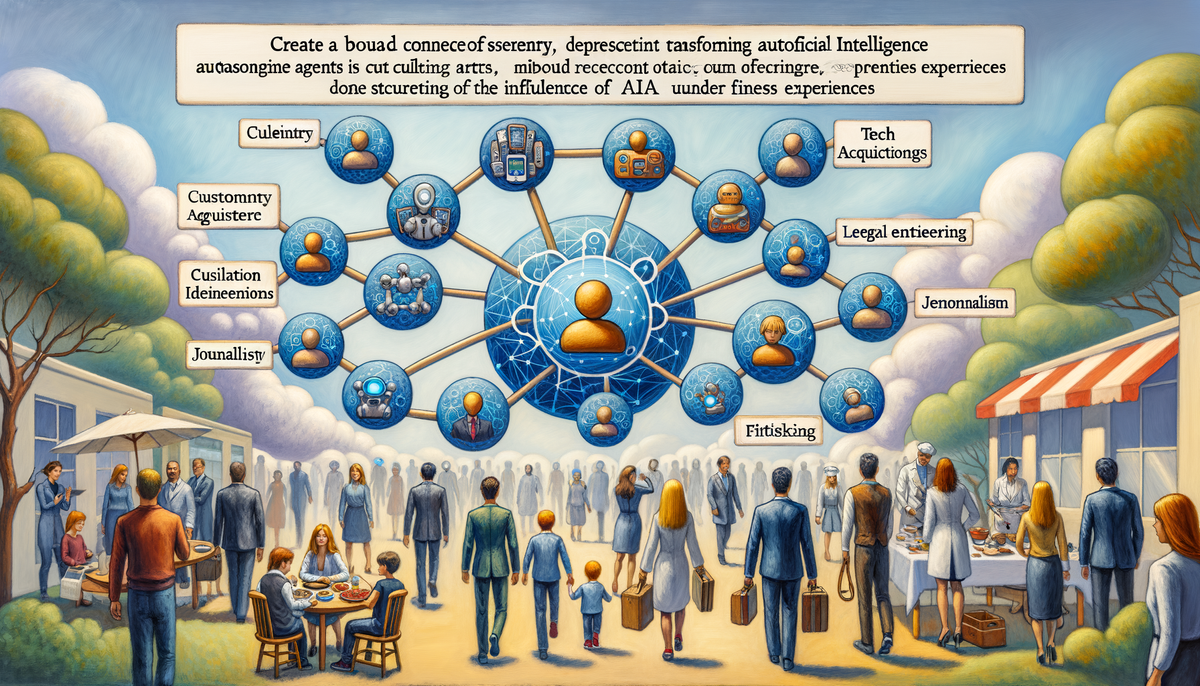AI Updates: Filevine's Triumphs, Nvidia's Acquisition, and Innovations in AI

This article explores the multifaceted influence of artificial intelligence across diverse sectors, from culinary arts and customer service to high-stakes tech acquisitions, journalism experiments, legal innovation, and even wearable fitness experiences. By analyzing recent case studies—ranging from an AI recipe generator that challenges traditional cooking methods, to award-winning AI platforms transforming customer support, and strategic moves by industry giants like Nvidia, Startek, Filevine, and Garmin—we delve into both the promise and the pitfalls of AI. This comprehensive exploration highlights how AI is continuously reshaping industries, offering transformative insights and, at times, exposing the need for a human touch.
AI in the Culinary World: Experimentation and Limitations
One striking application of AI is found in the kitchen, as illustrated by the exploration of AI-driven recipe generators. Platforms like SideChef’s RecipeGen, as detailed in a recent CNET article, have pioneered the concept of converting a simple photograph of a meal into a detailed recipe. The allure here lies in the seamless translation of visual aesthetics into culinary instructions—a novel idea where both experienced chefs and beginners can experiment with recreating restaurant-quality dishes at home.
However, the practical application of such technology has met mixed success. Consider the case of Amanda Smith, a dedicated foodie whose experience with the AI recipe generator was anything but flawless. When attempting to recreate a visually intricate brunch dish, the AI overlooked critical ingredients such as ricotta cheese and strawberry butter. This failure underlines a significant limitation of current AI systems: the challenge of capturing subtle nuances and flavor complexities evident in haute cuisine.
Interestingly, when applied to the more familiar territory of preparing sweet potato gnocchi, the same AI system performed relatively well, albeit at the risk of over-engineering the steps by suggesting alternative methods like baking instead of the established boiling technique. This leads to an overarching insight: while AI platforms excel at offering creative inspiration and generating novel combinations, they often require a seasoned human chef to correct, refine, and bring contextual knowledge into the process.
“A robot may not injure a human being, or, through inaction, allow a human being to come to harm.”
This adage from I, Robot serves as a reminder that, in the kitchen as in other sectors, AI should be viewed as a collaborative assistant—a supportive sous-chef rather than a replacement for human intuition and passion. Its value lies in sparking innovative ideas, yet it is the human element that ultimately perfects the art of cooking.
Generative AI in Customer Service: Marrying Efficiency with Empathy
Moving from the culinary sphere to customer service, another sector is witnessing a radical transformation due to AI: engagement, efficiency, and empathetic communication. Startek®'s breakthrough, as reported by PR Newswire, highlights a pivotal success in the integration of generative AI within digital customer experience solutions. Their AI-powered Startek® Agent Assist platform is designed to fuse technological efficiency with human empathy in customer interactions.
At the heart of this innovation is the ability to deliver real-time support to customer service representatives, spanning voice and non-voice channels, with a focus on making each customer interaction more personalized and dynamic. This creates a robust framework where agents can tackle problems in real time, supported not only by accurate data retrieval but also by intelligently tailored responses that add emotional nuance.
Abhinandan Jain, Chief Growth Officer at Startek®, emphasized that the AI breakthrough is about more than just technology—it’s about integrating human-centric design into AI to produce interactions that resonate on an emotional level. This positions Startek’s platform as a significant evolution within an industry that traditionally relied on script-based responses and standardized protocols.
Learn more about the advancing AI landscape where such integrations are becoming the norm and setting new standards in customer experience management.
By marrying human empathy with machine efficiency, organizations can not only streamline operations but also foster a deeper connection with customers—a critical factor in an era where digital interactions increasingly define brand reputation.
Nvidia and the Strategic Acquisitions: Fortifying AI Leadership
In the broader technology ecosystem, major players are not just adopting AI—they’re actively acquiring innovative startups to secure their competitive edge. Nvidia’s latest strategic move, reported in a recent Seeking Alpha article, offers a window into this dynamic. Nvidia, already celebrated for its contributions to the semiconductor and AI space, is reportedly in discussions to acquire Lepton AI. This prospective deal, rumored to be worth several hundred million dollars, could herald a new chapter in Nvidia’s evolution.
Lepton AI differentiates itself by renting out computing power bundled with Nvidia’s proprietary AI chips. This symbiotic setup promises not only to enhance Nvidia’s AI-driven data processing capabilities but also to escalate its impact on the cloud services market. The potential integration of Lepton AI’s technology into Nvidia’s expansive portfolio exemplifies a broader trend in the tech industry: the strategic incorporation of emerging intelligence solutions to stay ahead in a rapidly evolving digital landscape.
This acquisition isn’t merely a financial transaction; it represents a paradigmatic shift where AI acts as a critical determinant of competitive advantage. Strategic acquisitions like these are set against the backdrop of rigorous, ongoing research in AI optimization, offering fresh insights into machine learning, cloud computing, and data analytics. Analysts argue that such moves not only enhance operational capacities but also redefine industry benchmarks by accelerating advancements in AI hardware and software efficiency.
It’s a scenario where traditional market powerhouses blend innovation with legacy, ensuring that GPT-powered systems and machine learning algorithms remain at the cutting edge. Observers of the industry should eagerly follow the outcome of these negotiations, as they could potentially reshape the competitive dynamics not only for Nvidia but also for the wider semiconductor and AI markets.
Experimenting with AI in Content Creation: New Frontiers in Journalism
AI’s creative applications are also making headway into the realm of journalism. A recent investigative piece by ComputerWeekly.com's French counterpart, ComputerWeekly.com highlights the experience of a tech journalist who embraced free downloadable large language models (LLMs) to transform raw interview transcripts into polished articles.
The experiment involved testing models such as Google’s Gemma 3, Meta’s Llama 3.3, and models from Mistral, among others. Despite the promise of these advanced LLMs—some boasting up to 27 billion parameters—the results were marked by inconsistencies. Although the models could generate coherent narratives, they often lost track of key interview points and deviated into irrelevant content.
Technical constraints, such as memory utilization and parameter encoding, emerged as significant hurdles. It was observed that the more robust hardware architectures, like those found in Apple’s M1 Max chips, provided superior performance in managing large datasets; however, even these systems could not completely overcome the limitations inherent to current AI models. Many LLMs tended to produce convoluted sentences or overly promotional dialogue, with the Chinese model Qwen standing out as one of the more promising, albeit lesser-known, examples.
In an ironic twist, the promise of AI reducing human workload in content creation was met with a reality steeped in trial and error. Significant human intervention is still required to fine-tune prompts and ensure that the outputs align with journalistic standards. This delicate balance sparks a broader debate about the role of AI in creativity—an arena where human nuance and contextual understanding remain irreplaceable.
“By far, the greatest danger of Artificial Intelligence is that people conclude too early that they understand it.”
— Eliezer Yudkowsky, Artificial Intelligence as a Positive and Negative Factor in Global Risk
As we stand on the brink of an AI-driven transformation in content production, it becomes clear that these initial experiments are clues to a future where hybrid approaches—merging human insight with machine efficiency—could revolutionize media while still requiring significant human oversight.
Legal Innovation and AI: The Rise of Intelligent Legal Assistants
The legal sector, often perceived as resistant to change, is quickly embracing AI to overhaul traditional practices. Filevine’s remarkable achievements in this sphere, captured in a full-length GlobeNewswire article, illustrate the powerful impact of AI-based solutions like Depo CoPilot™ on modern legal practice.
Depo CoPilot™ emerges as a groundbreaking tool designed to act as a virtual assistant during depositions. By offering real-time transcription, immediate contradiction analysis, and AI-generated strategic questioning, the tool not only simplifies the arduous deposition process but also increases the precision of legal questioning. This integration of AI into legal proceedings demonstrates how traditional workflows are being streamlined into agile, technology-enhanced practices.
Legal innovation, as evidenced by Filevine’s award wins—including recognition for the Best Use of Artificial Intelligence in E-Discovery and Litigation—reinforces the risk-taking and pioneering vision inherent to today’s legal tech leaders. Moreover, the acknowledgment of industry pioneers like Filevine’s Senior Legal Futurist, Emily Lippincott, highlights a broader cultural shift in the law profession: a strategic embrace of digital tools to enhance overall effectiveness and client outcomes.
This evolution in legal processes serves as a microcosm of how AI is transforming industries by reducing human error, expediting otherwise slow procedures, and meeting the growing demand for speed and accuracy. Through the infusion of emerging technologies, legal professionals are finding new ways to navigate complex cases—a clear demonstration of how AI can empower industries that were once thought to be refractory to technological shifts.
Wearable Tech and AI: Enhancing the Personal Health Journey
Beyond industries such as journalism and legal services, wearables are also experiencing the AI revolution. Garmin’s introduction of the Garmin Connect+ tier, discussed in a recent TechRadar article, stands as a prime example of how artificial intelligence is elevating user experiences in the realm of personal health and fitness.
This new premium tier, priced competitively, introduces features underpinned by AI—such as “Active Intelligence”—which offers tailored insights and recommendations based on individual performance data. In a strategic maneuver, Garmin emphasizes that while Connect+ provides an enriched experience with advanced analytics and interactive functionalities (like improved LiveTrack and personalized training guidance), its core services remain free for all users. This thoughtful approach addresses concerns over potential feature lockouts and aims to maintain long-standing user loyalty in an increasingly competitive subscription-based market.
The integration of AI in Garmin’s ecosystem not only refines the quality of health insights but also reflects a shift in the consumer technology landscape. Instead of a one-size-fits-all model, consumers now have access to dynamic, data-driven feedback that evolves with each interaction. In this light, AI becomes a partner in personal health, empowering users to make more informed decisions about their fitness and lifestyle.
By carefully balancing innovation with consistent service quality, companies like Garmin are setting trends that could influence the future strategies of other wearable tech brands. This ensures that while premium tiers offer new, exciting possibilities via AI, the foundational promise of accessible technology remains intact—a reassuring continuity for loyal customer bases.
Insights and Reflections on AI’s Expanding Role
Taken together, these diverse stories paint a rich tapestry of artificial intelligence’s impact across industries. On one hand, AI-driven solutions offer unprecedented opportunities for innovation—from crafting recipes with a digital sous-chef to enhancing customer experience with emotionally intelligent platforms, from strategic acquisitions that promise to set new technological benchmarks to revolutionary tools in legal and wearable technologies.
Yet, as these examples reveal, AI is not without its imperfections. The challenges encountered with AI recipe generators and content creation models serve as important reminders of the limitations that still persist. There remains a critical need for human oversight, nuanced understanding, and the very human touch that transforms raw data into meaningful outcomes.
Reflecting on the insightful words of experts and memorable quotes from seminal works of AI fiction—like HAL 9000’s iconic line, “I'm sorry, Dave. I'm afraid I can't do that”—we are reminded that while AI offers potent tools, its directives and interpretations must be carefully managed. Moreover, as Eliezer Yudkowsky warns, early conclusions about understanding AI may conceal deeper complexities.
This dual-edged nature of AI, rich with both promise and pitfalls, invites a thoughtful conversation about our collaborative future with artificial intelligence. Whether applied in the creative first strokes of a new recipe, while unravelling the intricacies of customer dialogue or as an aid in legal depositions, AI continues to mature—its journey marked as much by daring innovation as by learning from its shortcomings.
Observing the continuous evolution in AI—from the groundbreaking moves by tech giants like Nvidia and Startek to innovative breakthroughs by companies transforming legal and fitness tech—one is compelled to think of the AI industry as an expansive, dynamic landscape. To punctuate this thought, another perspective might be drawn from the bold moves shared in our own Bespin Global article, which further outlines the transformative thrust leaders in AI are taking.
These developments concurrently challenge and invite us to reimagine the collaboration between human creativity and machine logic. As industries continue to explore the boundaries of what AI can achieve, our collective journey promises to be one of continuous learning, adaptation, and reinvention.
Further Readings
- Bespin Global's Bold Move into AI Leadership
- What you need to know about the advancing AI landscape
- Visa's AI Edge: Strengthening Security and Speeding up Data Retrieval
- Colle AI: Advancing Blockchain with AI-Optimized Transactions
Conclusion
As artificial intelligence continues to weave itself into every facet of modern life, from the intimate settings of our kitchens to the expansive realms of global tech strategy, one thing remains clear: AI is an evolving tool that both augments and challenges human ingenuity. Every success and shortcoming serves as a learning opportunity—a stepping stone that guides us toward a future where a synergistic partnership between people and machines will shape a new frontier of innovation.
In recounting these diverse narratives—from AI missteps in culinary art and mid-stream experiments in journalism, to award-winning innovations in customer service, legal tech, and wearable intelligence—we are witnessing more than just technological progress. We see a mirror of our own quest for excellence, a narrative where creativity, insight, and a gentle dose of skepticism help ensure that the future of AI remains both bright and responsibly guided.



Comments ()